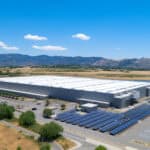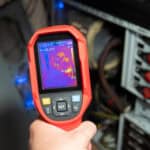
3 Cooling Challenges Driven by the Hyperscaler Land Boom
August 26, 2025
Current Cooling Limitations Slowing AI Data Center Growth
September 23, 2025Data centers have gained prominence over the last few years, with many people taking notice how they uphold large parts of our modern, digital society. Data centers are increasingly seen as the backbone of modern society. But they’re also under growing scrutiny.
As AI workloads surge and power demand accelerates, regulators are sharpening their focus on data centers’ energy use, water consumption, refrigerants, and thermal risk. With that in mind, and given the critical role cooling plays in data centers’ operations and environmental impact, cooling is a key part in ensuring compliance with industry standards and regulations. Whether you’re expanding an existing facility or building a new one, data center compliance isn’t optional, and staying ahead of regulation could be your competitive edge.
Let’s break down key cooling-related data center standards and regulations across the U.S., and offer a strategic guide to prepare for data center compliance.
Legally Binding Cooling-Related Data Center Regulations
Cooling systems can be subject to state, federal, and even local laws, particularly in regions where environmental impact is a major concern.
EPA SNAP Rules
The Federal Environmental Protection Agency’s (EPA) Significant New Alternatives Policy (SNAP) is part of the broader Clean Air Act. It “allows the EPA to evaluate substitutes for ozone-depleting substances and hydrofluorocarbons (HFCs) targeted by the American Innovation and Manufacturing Act (AIM)”.
The AIM Act mandates the phasedown of HFCs by 85% from historic baseline levels by 2036, a shift that has significant implications for data center cooling systems. Many cooling systems still rely on high GWP refrigerants, such as R-134a and R-410A, which are now among the 70 substances identified by SNAP as prohibited or restricted. These refrigerants are commonly used in CRAC units and ICT cooling infrastructure, meaning data centers must begin transitioning to lower-impact alternatives to ensure compliance and reduce environmental risk.
- Learn more about AIRSYS’ Refrigerant Transition
Data Center HIPAA Compliance
While not a regulation directly governing cooling systems, the Health Insurance Portability and Accountability Act (HIPAA) has serious implications for data center operations, especially those supporting healthcare providers or handling protected health information (PHI). HIPAA mandates strict safeguards to ensure data availability, integrity, and confidentiality.
A failure in the cooling system that causes server outages, data corruption, or prolonged downtime could result in inaccessibility of critical medical records, potentially violating HIPAA’s availability requirement. Such an incident may be viewed as a breach, exposing operators to fines, audits, and legal liability. As a result, resilient and properly maintained cooling infrastructure is a compliance necessity for any data center serving the healthcare industry.
State-Specific Regulations
While many cooling-related regulations originate at the federal level, a growing number of state and local governments are taking independent action to manage the environmental impact of data centers, especially in regions facing water scarcity, energy stress, or rapid infrastructure expansion. Here are key examples:
California:
California leads the nation in environmental policy, and its Building Energy Efficiency Standards, Title 24, Part 6, pertains directly to data centers. These energy efficiency standards apply to “all space-conditioning systems serving computer rooms” and include specific regulations for economizers, humidification controls, fan power consumption, and containment strategies. For example, the code states that “each individual cooling system primarily serving a computer room(s) shall include either an air or a water economizer capable of providing 100 percent of the cooling load at outside air temperatures.
Virginia:
Virginia has one of the highest concentrations of data centers in the U.S., especially in Loudoun County. While the state currently lacks uniform, statewide regulations, local governments are beginning to take a more active role in addressing environmental impacts. In June 2025, lawmakers debated House Bill 1601, which would have required data centers to conduct impact assessments on water use, agriculture, forests, noise, and historic sites before receiving zoning or special-use permits. Although the bill did not pass, it signals a growing push to more closely regulate the environmental footprint of data centers across the state.
Arizona:
Arizona’s desert climate and limited water resources make cooling efficiency and water conservation particularly critical. While there are no statewide regulations, local jurisdictions are pushing for policies to limit the environmental footprint of data centers. For instance, Chandler County enforces a policy dating back to 2015 that restricts data center water use to 115 gallons per day per 1,000 square feet of facility space. In Marana, a policy adopted in December 2024 prohibits the municipal water department from supplying potable water to a data center for its cooling system, humidity control, and other similar operations.
Not Legally Binding Data Center Standards
While not enforced by law, industry standards play a major role in shaping cooling systems’ design, procurement choices, and operational strategies of data centers.
ASHRAE 90.4 – Energy Standard for Data Centers
The American Society of Heating, Refrigerating, and Air-Conditioning Engineers (ASHRAE) developed Standard 90.4 to address the unique energy demands of data centers. This standard applies to “data centers with a conditioned floor space with a power density greater than 20 W/ft2 and IT equipment loads greater than 10 kW”, covering everything from compact edge facilities to hyperscale campuses.
One of the most relevant aspects of ASHRAE’s 90.4 for data center operators is how it guides the design and performance of mechanical cooling systems. The standard uses the Mechanical Load Component (MLC) to set efficiency thresholds for cooling infrastructure, encouraging the use of high-efficiency chillers, air handlers, and liquid cooling systems. It also provides thermal performance guidelines that help operators safely expand environmental setpoints to reduce energy consumption.
ASHRAE TC 9.9 – Thermal Guidelines and Cooling Best Practices
ASHRAE Technical Committee 9.9 (TC 9.9) focuses specifically on mission-critical environments, including data centers, telecom spaces, and electronics facilities. While not a “standard” in the legal sense, it publishes some of the most widely respected technical guidance for cooling, airflow management, and environmental conditions in IT environments.
A cornerstone of TC 9.9’s work is its publication of Thermal Guidelines for Data Processing Environments, which defines optimal ranges for temperature, humidity, and other environmental variables based on IT equipment capabilities. TC 9.9 also addresses cooling strategies such as airflow containment, air cooling, and liquid cooling. Notably, in September 2024, the committee released a Technical Bulletin on liquid cooling resilience, offering design strategies and failure mitigation recommendations as liquid cooling becomes mainstream for high-density and AI-driven workloads.
DOE Data Center Energy Guide
Released in July 2024 by the Department of Energy’s Federal Energy Management Program (FEMP), the Best Practices Guide for Energy-Efficient Data Center Design is one of the most actionable and up-to-date resources for energy-conscious data center design and operation. The guide emphasizes that data center efficiency isn’t the result of a single upgrade. Instead, it requires a holistic, systems-based approach across IT, power, and cooling infrastructure.
The guide outlines a range of strategies for advancing air management, such as cable routing to reduce airflow obstruction and hot/cold aisle containment. It promotes using high-efficiency components like variable frequency drives (VFDs) and variable flow pumps. It also explores the role of liquid cooling, heat reuse applications, and water-saving technologies to reduce environmental impact. Critically, the guide encourages operators to track energy-efficiency metrics like Power Usage Effectiveness (PUE), Water Usage Effectiveness (WUE), and Carbon Usage Effectiveness (CUE) to drive continuous improvement.
Cooling Compliance: How Data Centers Can Stay Aligned
The regulations and standards listed above reinforce that data center compliance is a strategic imperative, and not just a box to check. Here’s a practical checklist to help align your cooling strategy with the expectations of regulators, auditors, and customers.
Cooling Compliance Checklist for Data Centers
- Audit Your Cooling System: Check your PUE, refrigerant use, and water consumption. If you’re over 1.3 PUE, using HFCs, or relying on municipal water, it’s time to upgrade.
- Adopt Closed-Loop Cooling: Avoid water discharge and enable waste heat reuse with closed-loop liquid cooling; ideal for high-density 50kW+ AI racks and water-restricted environments.
- Reuse Waste Heat: Turn a liability into a revenue stream by capturing and repurposing excess heat.
- Track WUE & CUE: Go beyond PUE. Start monitoring WUE and CUE to stay ahead of emerging benchmarks.
- Partner with Reliable Compliance-Ready Vendors: Choose vendors that deliver cooling solutions engineered for regulatory compliance, energy efficiency, and environmental performance
Explore Cooling Solutions with AIRSYS
AIRSYS offers a robust portfolio of data center cooling solutions engineered for high performance, energy efficiency, and environmental responsibility. Whether you’re designing for hyperscale growth or upgrading existing infrastructure in a colocation or edge site, AIRSYS can help meet today’s compliance demands, while preparing you for tomorrow’s. Contact us to explore how we can support your next project.



